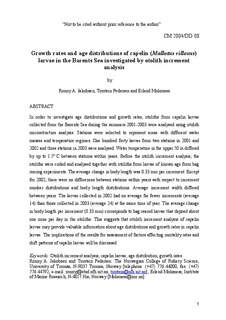Growth rates and age distributions of capelin (Mallotus villosus) larvae in the Barents Sea investigated by otolith increment analysis
Working paper

Åpne
Permanent lenke
http://hdl.handle.net/11250/100617Utgivelsesdato
2004Metadata
Vis full innførselSamlinger
Sammendrag
In order to investigate age distributions and growth rates, otoliths from capelin larvae
collected from the Barents Sea during the summers 2001-2003 were analysed using otolith
microstructure analysis. Stations were selected to represent areas with different water
masses and temperature regimes. One hundred forty larvae from two stations in 2001 and
2002 and three stations in 2003 were analysed. Water temperature in the upper 50 m differed
by up to 1.5o C between stations within years. Before the otolith increment analysis, the
otoliths were coded and analysed together with otoliths from larvae of known age from bag
rearing experiments. The average change in body length was 0.33 mm per increment. Except
for 2002, there were no differences between stations within years with respect to increment
number distributions and body length distributions. Average increment width differed
between years. The larvae collected in 2002 had on average far fewer increments (average
14) than those collected in 2003 (average 24) at the same time of year. The average change
in body length per increment (0.33 mm) corresponds to bag-reared larvae that deposit about
one zone per day in the otoliths. This suggests that otolith increment analysis of capelin
larvae may provide valuable information about age distributions and growth rates in capelin
larvae. The implications of the results for assessment of factors affecting mortality rates and
drift patterns of capelin larvae will be discussed.
Utgiver
ICESSerie
ICES CM documents2004/DD:08